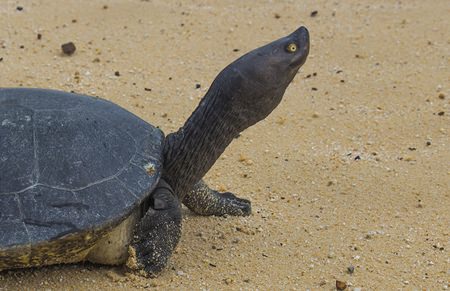Phnom Penh, Cambodia (AP) – Cambodia’s Royal Turtle is nearly extinct, with fewer than 10 left in the wild, because increased sand dredging and illegal clearance of flooded forest have shrunk its habitat, a conservationist group warned Monday, April 25.
The New York-based Wildlife Conservation Society said in a statement that for several years the small remaining population of Royal Turtles, “perhaps numbering fewer than 10,” have been successfully protected in the Sre Ambel River system by a joint project of the government’s Fishery Administration and WCS.
 In this June 24, 2015, photo released by Wildlife Conservation Society, a Cambodian Royal Turtle walks on the sand of a Sre Ambel river bank, in Koh Kong province, western Phnom Penh, Cambodia. (Wildlife Conservation Society via AP)
In this June 24, 2015, photo released by Wildlife Conservation Society, a Cambodian Royal Turtle walks on the sand of a Sre Ambel river bank, in Koh Kong province, western Phnom Penh, Cambodia. (Wildlife Conservation Society via AP)
But a recent increase in disturbance along the river system in Koh Khang province, the only place the turtle is still found in Cambodia, is putting the species at great risk, it said.
The Royal Turtle is one of the world’s 25 most endangered tortoises and freshwater turtles. Also known as the Southern River terrapin, the Royal Turtle is so named because in historical times only the royal family could consume its eggs. The species was designated as Cambodia’s national reptile in 2005.
This year the project team observed a decline in the turtle’s nesting. “We believe this is caused by increased sand dredging, wood transportation along the nesting habitat, and illegal clearance of flooded forest disturbing the females during the breeding season,” said In Hul, the project coordinator.
Only one nest was located this year, compared to four last year. “This is very worrying and if it continues it will be potentially putting the species at high risk of extinction,” he said.
The Royal Turtle was believed extinct in Cambodia until 2000 when a small population was re-discovered. In 2001, the government and WCS began a project to search for and protect nests. They have saved 39 nests with a total of 564 eggs that resulted in 382 hatchlings. Although the hatchlings are taken into captivity to be raised and released into the wild later, the loss of habitat reduces their chances to survive, officials say.




